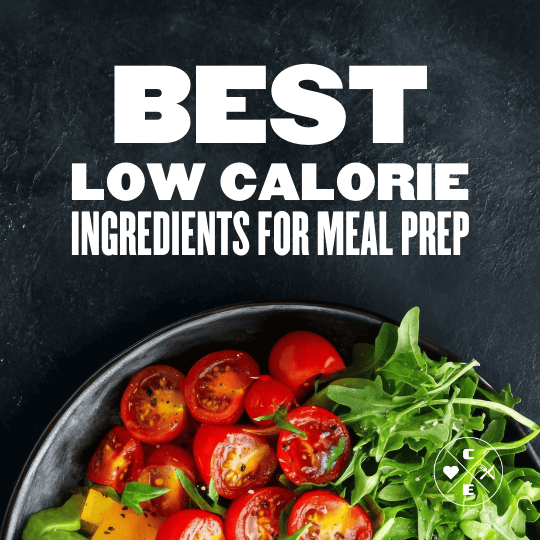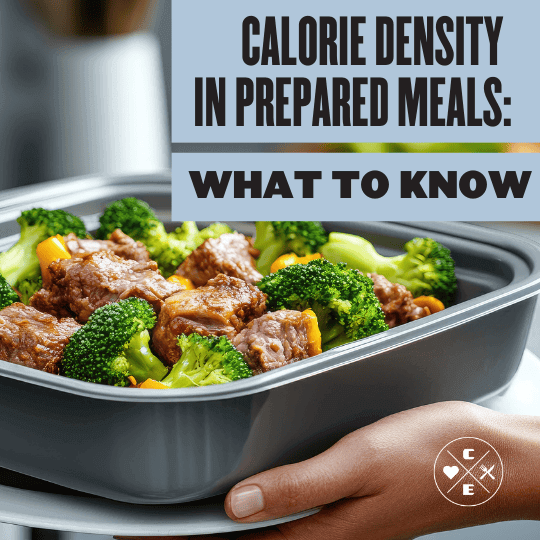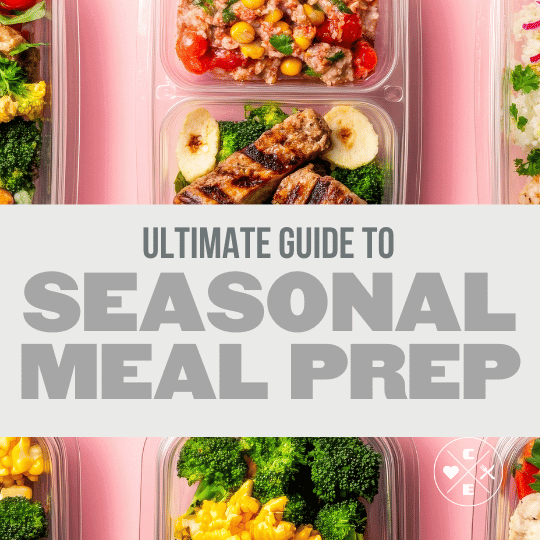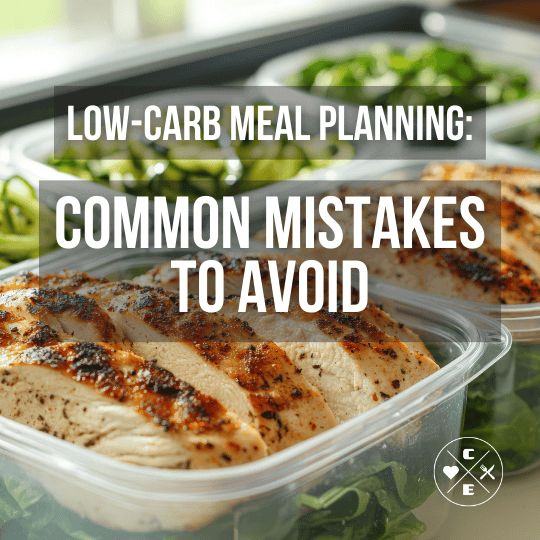
Best Low-Calorie Ingredients for Meal Prep
Jason Nista
Nutrition
|
Healthy Recipes
8 minute read
Table of Contents
Want to eat healthy without sacrificing flavor or convenience? Here’s how:
- Lean Proteins: Choose chicken breast, fish (like cod or salmon), or plant-based options like tofu and egg whites for high protein and low calories.
- Non-Starchy Vegetables: Add volume with leafy greens, broccoli, zucchini, and bell peppers - low in calories but rich in nutrients.
- Smart Carbs: Opt for whole grains (quinoa, brown rice) or root vegetables (sweet potatoes, spaghetti squash) for energy and fiber.
- Flavor Boosters: Use lemon, lime, or vinegar to enhance dishes without adding calories.
Quick Tips:
- Portion meals with tools like measuring cups or use the “hand guide” (e.g., palm-sized protein, two fists of veggies).
- Cook in bulk and store meals properly to save time and keep food fresh.
Meal prepping with these ingredients helps you manage weight, save time, and enjoy delicious, balanced meals every day.
Ingredients I Prep For the Week
Lean Proteins for Meal Prep
Lean proteins help maintain muscle while keeping calorie intake in check, making them a key part of balanced meals. Clean Eatz Kitchen offers portion-controlled options to align with your nutrition and fitness goals.
Chicken Breast
Skinless chicken breast is a go-to option, offering about 130 calories and 26 grams of protein per 4-ounce serving. For the best results, trim any visible fat and try these cooking methods:
- Baking: 375°F for 25–30 minutes
- Air frying: 360°F for 18–20 minutes
- Grilling: 6–8 minutes per side
Fish Options
Fish is another excellent source of protein with relatively low calories. Here’s a quick comparison of common choices:
| Fish Type | Calories (4 oz) | Protein (g) | Suggested Cooking Method |
|---|---|---|---|
| Cod | 95 | 21 | Baked or broiled |
| Tilapia | 110 | 23 | Pan-seared |
| Salmon | 180 | 24 | Grilled or roasted |
Meat-Free Proteins
For plant-based options, extra-firm tofu and liquid egg whites are great choices:
- Tofu: A 4-ounce serving has about 80 calories and 9 grams of protein. Press it for 30 minutes before cooking to remove excess moisture.
- Liquid Egg Whites: These pack 13 grams of protein and 60 calories per ½ cup, making them ideal for breakfast bowls or stir-fries.
Up next, we’ll look at non-starchy vegetables to pair with these proteins.
Non-Starchy Vegetables
Non-starchy vegetables are a fantastic way to add volume and nutrients to meals without piling on the calories. These ingredients help create filling portions while keeping your calorie intake in check.
Leafy Greens
Leafy greens pack a nutritional punch and bulk up meals with minimal calories:
| Green Type | Calories per Cup | Prep Method | Storage Life |
|---|---|---|---|
| Baby Spinach | 7 calories | Wash, dry thoroughly | 5-7 days |
| Kale | 33 calories | Remove stems, chop | 7-10 days |
| Romaine | 8 calories | Chop, store with paper towel | 4-5 days |
Store greens in airtight containers lined with paper towels to keep them fresh. For kale, try massaging it with a bit of olive oil to make it softer and easier to enjoy.
Next up: cruciferous vegetables, which add texture and fiber to your meals.
Broccoli and Cauliflower
Broccoli and cauliflower are excellent meal prep options. They’re sturdy, hold their texture when reheated, and offer about 30 calories per cup along with plenty of fiber.
Popular ways to prepare them:
- Roasting: Bake at 400°F for 20-25 minutes until the edges are crispy.
- Steam-sautéing: Cook for 8-10 minutes with 2 tablespoons of water.
- Air frying: Set to 375°F for 12-15 minutes.
For meal prep, cut them into uniform 1-inch florets. Store pre-cut portions in airtight containers, and they’ll stay fresh for up to 5 days.
Low-Calorie Veggie Sides
Add variety to your meals with these low-calorie options:
- Zucchini (20 calories per cup): Great for spiralized noodles, grilled slices, or diced in stir-fries.
- Bell Peppers (30 calories per cup): Perfect for fajitas, omelets, or sliced as a snack.
- Green Beans (31 calories per cup): Blanch for 3 minutes, roast at 375°F for 15-20 minutes, or steam for 5-7 minutes.
To keep veggies crisp throughout the week, avoid seasoning them until you're ready to reheat. Clean Eatz Kitchen uses these vegetables in their prepared meals, offering balanced portions with plenty of nutrients.
sbb-itb-1989a25
Smart Carb Choices
Choosing the right carbs can add flavor and texture to your meals without piling on the calories.
Whole Grains
Whole grains are packed with nutrients and taste great:
| Grain Type | Calories (1 cup cooked) | Cooking Time | Meal Prep Tips |
|---|---|---|---|
| Quinoa | 222 calories | 15-20 minutes | Toast before cooking for a nutty flavor |
| Brown Rice | 216 calories | 40-45 minutes | Rinse until water runs clear |
| Farro | 200 calories | 25-30 minutes | Soak overnight to cut cooking time |
| Barley | 193 calories | 35-40 minutes | Add extra water for a softer texture |
Meal Prep Tips: Cook grains in low-sodium broth to enhance flavor. Once cooled, portion them into airtight containers with a paper towel to absorb moisture. Store in the fridge for up to five days.
Pair these grains with root vegetables to add variety and nutrients to your meals.
Root Vegetables
Root vegetables are a great source of fiber and complex carbs, and they're low in calories:
Sweet Potatoes (103 calories per cup, cubed):
- Cut into cubes and roast at 400°F for 25–30 minutes.
- Toss with cinnamon and olive oil for a flavorful twist.
- Store in the fridge for up to four days and reheat in a microwave or air fryer.
Spaghetti Squash (42 calories per cup):
- Slice lengthwise, scoop out the seeds, and roast cut-side down at 400°F for about 40 minutes.
- Use a fork to create spaghetti-like strands - perfect as a base for protein and sauces.
Butternut Squash (82 calories per cup, cubed):
- Cube into 1-inch pieces and roast at 375°F for 25–30 minutes.
- Add to grain bowls or salads for a hearty addition.
- Maintains its texture throughout the week.
Clean Eatz Kitchen includes these carb options in their meals, making it easy to enjoy healthy and delicious choices.
Calorie-Free Flavor Boosters
Acid Elements
Once you've chosen your low-calorie proteins, veggies, and carbs, take your meal up a notch with acid-based flavor enhancers that add zest without adding calories. A quick squeeze of lemon or lime can make proteins pop, while a splash of vinegar - like balsamic or rice vinegar - elevates the taste of roasted veggies or grain bowls. Clean Eatz Kitchen uses these simple tricks to create meals that are flavorful and still meet your nutritional needs.
Meal Prep Success Tips
Once you've selected your low-calorie ingredients, it's time to focus on portioning, cooking, and storage to make your meal prep a breeze.
Portion Control
Getting portions right is key to keeping meals low-calorie. Use tools like measuring cups and a digital scale for accuracy. For proteins, stick to 4-6 oz per serving. Fill half your container with non-starchy veggies (around 1-1.5 cups) and limit complex carbs to ¼-½ cup per meal.
You can also use this simple "hand guide" for portioning:
- Protein: Palm-sized portion (4-6 oz)
- Carbs: Cupped hand (½ cup)
- Vegetables: Two fists (roughly 2 cups)
- Healthy fats: Thumb-sized portion (1 tablespoon)
Cooking Methods
Use these cooking techniques to maintain flavor while keeping meals healthy:
- Vegetables: Steam them to lock in nutrients or roast at 400°F with a light olive oil spray. Roasting adds natural sweetness without extra calories.
- Proteins: Air fry at 375°F with minimal oil for a crispy texture. For more tips, check the protein section.
- Batch Cooking: Save time by cooking in bulk. Roast several sheet pans of different veggies at once to add variety to your meals.
Storage Guide
Proper storage keeps your meals fresh and safe to eat. Use airtight containers and portion out your meals immediately after cooking.
How long can you store food?
- Cooked proteins: 3-4 days
- Cut vegetables: 4-5 days
- Cooked grains: 5-7 days
- Sauces: Up to 5 days
Make sure your refrigerator is set to 40°F or lower. Let food cool completely before refrigerating, and never leave it out for more than 2 hours.
To stay organized, label containers with the date and contents, and place newer items behind older ones. These habits will keep your meal prep fresh, safe, and ready to support your health goals.
Summary
Here’s a quick recap of the key strategies from this guide:
Low-calorie meal prep starts with thoughtful ingredient selection and careful portioning. Focus on lean proteins, non-starchy veggies, and complex carbs to keep your meals nutritious and satisfying.
Adjust portions to match your goals. For example, you can boost protein while keeping carbs moderate if you're aiming for a higher-protein plan. Using fresh, seasonal ingredients not only enhances flavor but also adds nutritional benefits.
A consistent meal prep routine can set you up for success. Stick to balanced, portioned meals made with fresh ingredients - an approach inspired by the Clean Eatz Kitchen way - to support your long-term health goals.
Related Articles
Calorie Density in Prepared Meals: What to Know
7 minute read
Ultimate Guide to Seasonal Meal Prep
9 minute read
Low-Carb Meal Planning: Common Mistakes to Avoid
8 minute read



